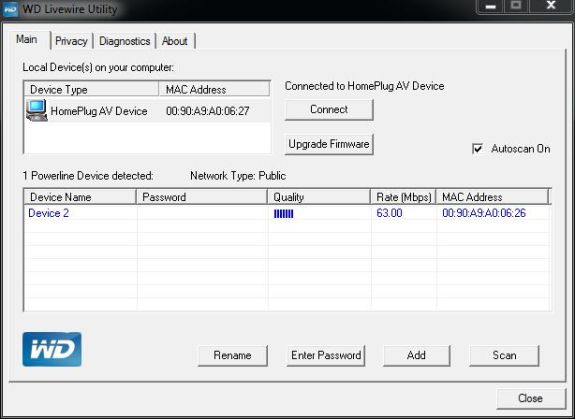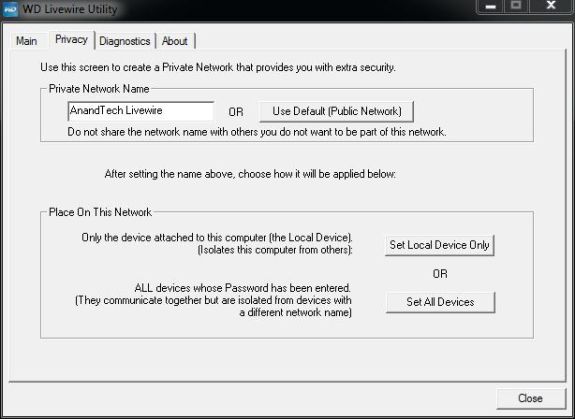Powerline Networking with the Western Digital Livewire
by Ganesh T S on August 24, 2010 7:50 AM EST- Posted in
- Gadgets
- Networking
- Powerline Adapters
The WD Livewire comes in a box with the bare essentials. Unlike the WDTV Live, there aren't as many cables or batteries to deal with. Opening the package reveals a pictorial setup guide, the warranty document and the setup CD. Beneath this, we have a pair of powerline kits. Each kit consists of a 4 port routing unit, along with a short Ethernet cable and an AC power outlet connector. The routing unit is made of black plastic with a WD logo on the top side. It blends well in any sort of setup, and is quite similar in structure to the WDTV Live, except that it is not as thick. This can be seen quite clearly in the photograph below.

Setup CD / Documentation not shown
Setup is very straightforward, even for the non-technical folks. One port of the routing unit is connected to the main router's outlet ports. The other ports in the routing unit (there are 4 ports on each) can be used as an extender for the main router, thereby acting as a port multiplier. This will not be ideal of the router is Gigabit in nature, as all the outlet ports of the routing units in the powerline kits are only Fast Ethernet (100 Mbps). This routing unit is connected to the power outlet. We are not aware of any other powerline adapter kit which can also be used as a port multiplier at the source point (on the main router side).
The other routing unit can be connected to any power outlet in the residence, making available 4 Ethernet ports at that power outlet for usage. It is not hard to imagine requiring four ports at the second power outlet, particularly if it is the entertainment center. A large number of TVs, Blu-Ray players (and the WDTV Live, as well) and other entertainment center components come with an Ethernet port for connecting to the Internet as well as the home network. The package goes to great lengths (to the extent of placing stickers to cover up the power outlet plug point on the routing unit) to make sure that users don't connect it to a power strip or surge protector. This is an advice provided with good intentions, as we personally saw some of the low cost surge protectors halving the available bandwidth. This will be covered in detail in the benchmarking section.
It is not essential to run the installation CD, as we were able to get up and running without it. However, for people who want to secure their powerline network, the installation CD comes with a Livewire utility. As can be seen from the screenshots below, the utility allows firmware updating, and also indicates the powerline kits available on the network (other than the primary one connected to the router). We also get an indication of the bandwidth available on that particular device.
The Privacy tab allows the user to setup a name for the Powerline network, and gives an option to only allow devices on which the password has been entered. The entering of the password referred to in the screenshot actually implies the pressing of the 'Sync' button on all the powerline kits which are intended to become part of the private network. This has to be done for less than 3 seconds on each, but not more than 2 minutes apart.
WD also supplies a 26 page PDF manual with detailed setup and troubleshooting details. All said, the packaging of the kits is professional, and setup is quite straightforward for even the novice users. Most people should get up and running in no time, provided they do not need to mess with private networks of any kind.












31 Comments
View All Comments
BubbaJoe TBoneMalone - Tuesday, August 24, 2010 - link
I use a USB stick to transfer video content from from my computer to my HD TV via the WD TV Live HD Media Player. I love this but will wait for the upcoming Atheros AR7400 chipset and its testing of 1080p content at AnandTech. :)glugglug - Tuesday, August 24, 2010 - link
Installing ethernet wiring is much cheaper than this, particularly when for the lengths you will want to run it through the home, likely going through walls, you will end up making your own cables.I bought 500ft of CAT5e, along with a bag of end connectors and a crimping tool all together for $35 off e-bay. It was not difficult to find the pin-outs needed online and crimp my own cables.
I needed the performance and reliability of wired ethernet rather than wired because I am using it with Media Center Extenders to stream TV throughout the apartment.
In applications like this that require good performance and have more than 2 nodes, powerline networking is not a fit because it acts like a hub rather than a switch - so there will be network collisions - and yet it costs more. If you don't need the peformance, wireless is more convenient. So that basically leaves no situations in which powerline networking is the correct solution.
dijuremo - Tuesday, August 24, 2010 - link
You are missing the point that not everyone want/can run cat5/cat6 on their homes. Not everyone has the expertise or time to go through sheet rock, fish cables, etc, specially if you are going between floors in a 2 or more story home. The product is aimed to those people, not the tech savy guy who is not afraid of cutting sheet rock, pulling wire and crimping it.For a regular person, it would be easy to plug the device to the power lines in two locations and that is it, they are done, no sheet rock cutting and patching, dealing with fiber insulation, fishing wire, etc. Is it the best way? No, Is it the easiest way? Yes.
mmatis - Wednesday, August 25, 2010 - link
Or what about anyone who is renting their home? Do you think the owner is gonna want them pulling cable? Not that ANYONE is renting these days with the outstanding real estate market that we are currently in...BPB - Tuesday, August 24, 2010 - link
What about a home built in the late 60's or earlier that is two stories high? One not built with the intent of being re-wired, so there are many obstacles. It's for reasons like this that people consider "wireless" options. I'd love to wire my place with ethernet cable, but it just isn't worth the hassle.Dravic - Tuesday, August 24, 2010 - link
Time was a factor for myself...I have plenty of CAT cable for the job, and have built many cables in my time as a network admin. With a full time job, 3 kids, and learning android programming.. I neither had the time or will to patch and paint after running cables in my home. An contractors tend to do a crappy job, or a "good enough" job.
I have 2 netgear powerline 200Mbps adapters connecting my main floor with my office upstairs (delivers all 25/25 of my FIOS easily). I attempted a 3rd adapter in the basement with the 360, HD tv, and slingbox but with too many serial power drops i couldnt get a reliable signal. So i went with a pair of netgear MOCA land bridges from the basement to the main floor over coax.
After years of dealing with crappy Wireless WDS solutions(speed halved, only WEP in wds, resets) , the Powerline adapters and MoCA bridges have given man "wired" conenctions from the 2nd floor to the basement. Now i can stream my sling box at its highest setting, and im wire speed for 360 (games and netflix).
~$300 (powerline kit and moca bridge kit), so its a bit pricey, but its done, works, and i didn't have to patch and paint any more then i already do with a wife and 3 kids...
knight511 - Tuesday, August 24, 2010 - link
It is easy to fail to see the benefits of powerline networking when you live in an apartment. Once you are in a house and you are trying to set up your entertainment system and your network, you will look at 500ft of cat 5 and think "Isn't that cute." Powerline networking has been of interest to me (and I am sure I am not the only one) because my entertainment system in my living room is on an exterior wall of the house. It is much more difficult to run ethernet cable to an exterior wall (especially in a room with a vaulted ceiling which limits the crawl space in the attic) unless you are okay with the eye sore of cable being run down the outside wall of your house. I have gone through great lengths to have only a single cable (RG6 for my cable) on the exterior of my house (and I am talking a run of less than 15 feet as it exits the attic at the soffit and runs down and through the wall to the TV location)... the last thing I want is a bunch of cat-5 run around the exterior of my house.Unfortunately, this product doesn't look like the answer I was searching for either... it looks like a day or so in the attic getting the cat-5 dropped "close enough" to the entertainment center still lays in my future. :-)
chromatix - Tuesday, August 24, 2010 - link
...amateur radio operators nearby may wind up being interfered with - where "nearby" could be miles away. They don't like that, and the more proactive ones might track down your house as the source of it and put a polite note through the door telling you about it.The problem is quite fundamental - in order to get that kind of data bandwidth through a wire, it is necessary to use a lot of signal bandwidth - and that means you are sending high-frequency wide-bandwidth signals through wires designed to carry only 50Hz. These wires then radiate a lot of this energy into the surroundings, and despite notches having been cut in the spectrum for this purpose, some of that energy is in the bands that radio operators are trying to listen for weak signals on.
Ethernet, being made of twisted pairs, is designed to not radiate the signals transmitted through it. This is also why Cat6, with more twists in it, is preferred for GigE.
ganeshts - Tuesday, August 24, 2010 - link
chromatix,Do you have any documented cases of this happening? I believe the HomePlug AV standards make sure that the operating frequency bands do not interfere with spectrum already in use.
Thanks.
chromatix - Tuesday, August 24, 2010 - link
From http://en.wikipedia.org/wiki/Power_line_communicat..."The British communications regulator Ofcom has investigated a number of PLT-related complaints but nearly 20% of these remain unresolved.[13] Ofcom maintains that "there does not at present appear to be significant public harm arising from this situation." [14] Since publishing this statement, Ofcom was presented with evidence by the RSGB (Radio Society of Great Britain) that PLT is causing significant disruption to Amateur Radio and Shortwave broadcast resulting in Ofcom commissioning a report into the interference being caused by the technology. [15]"
Feel free to follow up the references. It's mostly talking about long-distance BPL (Broadband over Power Lines), but the home-network stuff is fundamentally similar - and there's nothing in your home wiring to prevent these signals from extending some distance into the wider grid. They would probably be stopped at the nearest step-down or balancing transformer.